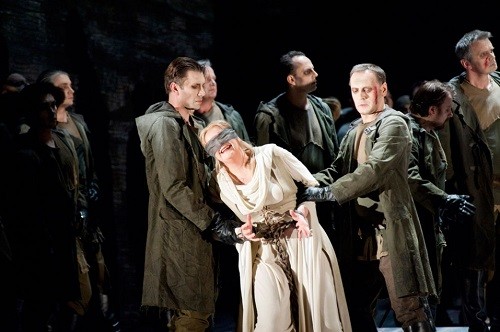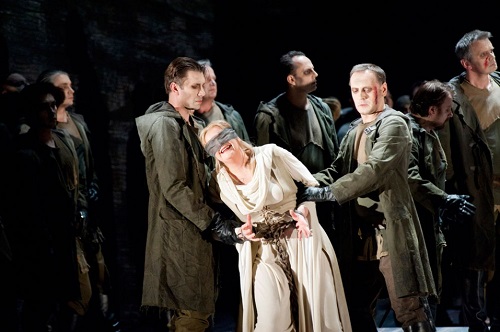 Germany Wagner – Lohengrin: Soloists, Chorus and Supplementary Chorus (chorus master: Jeremy Bines) and Orchestra of the Deutsche Oper, Berlin / Donald Runnicles (conductor). Deutsche Oper, Berlin, 10.9.2017. (MB)
Germany Wagner – Lohengrin: Soloists, Chorus and Supplementary Chorus (chorus master: Jeremy Bines) and Orchestra of the Deutsche Oper, Berlin / Donald Runnicles (conductor). Deutsche Oper, Berlin, 10.9.2017. (MB)
Cast:
King Henry the Fowler – Marko Mimica
Lohengrin – Brandon Jovanovich
Elsa – Rachel Willis-Sǿrensen
Friedrich von Telramund – Thomas Johannes Mayer
Herald – Dong-Hwan Lee
Ortrud – Anna Smirnova
Brabantian Noblemen – Ya-Chung Huang, Andrew Dickinson, Byung Gil Kim, Dean Murphy
Pages – Saskia Meusel, Andrea Schwarzbach, Cordula Messer, Martina Metzler
Lohengrin – Brandon Jovanovich
Elsa – Rachel Willis-Sǿrensen
Friedrich von Telramund – Thomas Johannes Mayer
Herald – Dong-Hwan Lee
Ortrud – Anna Smirnova
Brabantian Noblemen – Ya-Chung Huang, Andrew Dickinson, Byung Gil Kim, Dean Murphy
Pages – Saskia Meusel, Andrea Schwarzbach, Cordula Messer, Martina Metzler
Production:
Kasper Holten (director)
Steffen Aarfing (designs)
Jesper Kongshaug (lighting)
Claudia Gotta (revival director)
Steffen Aarfing (designs)
Jesper Kongshaug (lighting)
Claudia Gotta (revival director)
The last time I had seen Lohengrin at the Deutsche Oper it must have been one of the final performances of the Götz Friedrich production. It had worn well; indeed, I wrote that ‘it would be better to retain Friedrich’s production for a while longer than to err by rushing into replacing it.’ On the basis of seeing this, already the twenty-fourth performance of Kasper Holten’s production since it was first staged in 2012, there was no rushing, although the pace of change was nevertheless swift. Holten’s staging at its best, especially in the second and third acts, has something pertinent and – to me, at least – new to say. It has made me think about a work I know reasonably well, which is surely precisely what we should hope and look for in new stagings of repertory works.
Holten’s production has three main strands, in which Steffen Aarfing’s designs and Jesper Kongshaug’s highly dramatic lighting, play, as one would hope, an integral part. The first seems to me less successful, although it is always difficult to know how much of that is a matter of changes made once a work is in repertoire and rehearsal time available. The wartime setting of the work is highlighted, but intermittently. I tend to think it should either be more present or less; as it is, the slight coming and going of what seems almost to be a Konzept proves a little distracting or even confusing. It is certainly to the fore in the First Act Prelude – conducted, by the way, with magnificent breadth and depth by Donald Runnicles: perhaps his very finest moment here – when we see a battlefield, strewn with corpses, which women then visit in grief, one emitting a very loud scream indeed at orchestral climax. (It will be echoed by Elsa when she sees Gottfried’s corpse at the close: a powerful moment indeed.) Holten says that he views the Prelude as a kind of requiem, which seems to me a misunderstanding of both music and mass, but anyway. Uniforms are to the fore throughout, suggesting soldiers from different eras, the light mixing of eras intentional, so as not to fix, although again I am not sure to what end precisely. War between Germany and Denmark over Schleswig-Holstein, appropriately enough, seems to have formed part of Holstein’s inspiration, even though it came some time after Lohengrin’s genesis and first performance. There is certainly particular resonance in Berlin to the heavy royal-imperial imagery of Prussia-Germany, not least in the Tiergarten’s Siegessäule, albeit purely in the memorial sense, rather than as the queer emblem it has since become: perhaps a missed opportunity.
For there seems little doubting Lohengrin’s agenda. Whatever it is he is hiding, it is not in pursuit of anything other than what we should expect. He acts in unusually predatory fashion towards Elsa in the third act – quite chilling, in fact – and treats her with utter contempt thereafter. If he is not going to have her, then what is the point? Otherwise, he is, quite simply, a politician: a charismatic politician, yes, but one we can see through immediately and do. I do not think I have seen so unremittingly negative a portrayal of the ‘hero’ in this work, and it works very well indeed, confronting one with questions one might prefer never to have been asked, let alone answered. The angel wings – an angel, a memorial, a swan? – are taken off once in private. The crowd loves them, though, and he responds in kind, snake oil salesman, perhaps even thaumaturge, that he is. Does this disregard the text unduly? I do not think so, for what he says gains new meaning in such a context. Is he lying? Is Wagner? Or is he at least deluded? The legacy of the charismatic hero, not least in the wake of war, is after all a problematic one, to say the least, especially in Germany. (It is in that respect that I wished the wartime idea had been pressed further, since it comes across a little unclearly in the crucial final scene.) If only Wagner’s original ‘Führer’ had been retained, as it was, for instance, in Peter Konwitschny’s celebrated staging, which I saw in Leipzig. None of this, of course, would have been possible without a fine performance in the title role. We certainly had that, however, in the case of Brandon Jovanovich, whose engagement with complexities of work and production was unquestionably one of the finest I have seen and heard. This was no unearthly hero; this was a preening, fatally attractive man and politician, whom we knew would lead us to rack and ruin, although we felt unable to stop him. Jovanovich’s range of vocal colours proved far greater than in many assumptions of the role: never, however, for its own sake, but always in the service of the drama.
Elsa’s self-realisation is the other main strand – or at least was for me. Perhaps it was a matter of execution, or my own reception, but I did not feel that her role, where she was coming from, and what quite was going on came across strongly enough in the first act. Yes, she is blindfolded, and will soon begin to see, but her progress through the crowd, intriguingly led by Ortrud, seems a little confused, and not in a good way. Thereafter, though, the idea, familiar through Holten’s Copenhagen Ring, of viewing the work from a heroine’s standpoint has much to recommend it, especially when the tragedy truly becomes hers. The crowd remains in Lohengrin’s thrall, but Elsa has discovered disillusionment, even the abyss. Rachel Willis-Sǿrensen’s performance in the first act proved somewhat disappointing, her shrillness of tone extending into sections of the second too. However, she picked herself up commendably, and ended up giving a splendidly engaged performance, meriting the character’s shift into the dramatic foreground.
There was much to enjoy in other performances too. Thomas Johannes Mayer was suffering from a heavy cold, but did a sterling job under the circumstances. Some, I suppose, might have found the vibrato of Anna Smirnova as Ortrud a little much. I did not, for there was always a centre to her singing. Moreover, if there were occasionally a little of the pantomime villainess to her stage action, I suspect that was part of the point; if not, it nevertheless grabbed the attention. She was certainly giving the performance her all, and that was really what mattered. Marko Mimica proved a subtle King Henry, the competing demands of role and production – not for the first time, we are moved to ask ‘how does he fit into all of this?’ –questioningly, fruitfully balanced. Choral singing, as one might expect at this house, was excellent, as was the playing of the Orchestra of the Deutsche Oper, very much in its element throughout. Runnicles paced the work well, its ebb and flow apparent without being forced upon one’s attention. There was something attractively self-effacing, although far from anonymous, to conducting that was clearly born of deep knowledge of Wagner’s score.
Mark Berry
